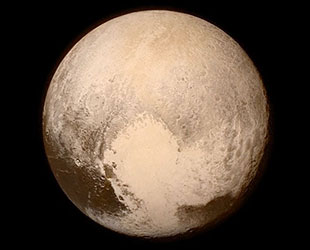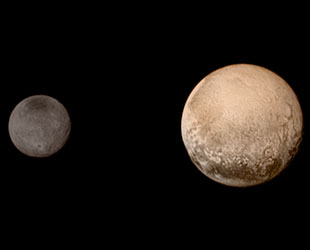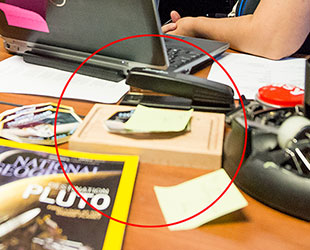July 14, 2015 — By the time you read this, NASA's New Horizons spacecraft should be somewhere beyond Pluto, having completed a historic first flyby of the dwarf planet.
That is, if it survived the encounter.
Knock on wood.
The piano-sized probe, which was launched to the dwarf planet nine and a half years ago in 2006, was scheduled to make its closest approach to the dwarf planet at 7:49 a.m. EDT (1149 GMT) on Tuesday (July 14). Operating on its own, because New Horizons is traveling extremely fast — 30,800 mph (49,600 kph) — and it takes four hours and 25 minutes for a signal to stretch across the 3 billion miles (5 billion km) between Earth and Pluto, the spacecraft's fate won't be known until 8:53 p.m. EDT (0053 GMT) when its call home is expected to arrive.
"The combination of the high speed of the New Horizons spacecraft and the exploration nature of this mission could bite us," principal investigator Alan Stern told reporters on Monday. "We've taken what we think is a measured risk."
The concern is tiny pieces of moon debris.

New Horizons' last and most detailed image of Pluto as captured on July 13 before its closest approach. (NASA/JHUAPL/SWRI) |
Pluto and its moons are located in the Kuiper belt, a third zone of our solar system made up of icy bodies and small objects out beyond the orbit of Neptune.
"It's more or less a shooting gallery," said Stern, "with lots of primordial comets and other things that are smaller than Pluto. And when those things strike the small satellites, of course they make a crater."
"All the material excavated from the crater actually leaves the satellite and it goes into orbit around Pluto," he said.
Pluto's smallest moons – Styx, Nix, Kerberos and Hydra – don't have enough gravity to hold onto the material ejected by the impacts, and the debris is not moving fast enough to escape the Pluto system. As such, that debris posed a small, but notable risk to New Horizons.
"We have searched for debris that may be in the system on approach using our best instruments and found nothing — nothing of concern," Stern said.
Mission managers calculated the odds that New Horizons would be lost due to a debris strike to be 1 in 10,000.
"New Horizons will be out of touch for those hours around closest approach and while I don't lose sleep over this, the fact is there is going to be a bit of drama," said Stern. "We want for the spacecraft to check back in, we want to look at the telemetry that is coming down and make sure the spacecraft hasn't suffered any alarms. And until we pass that point, we will not really know with certainty that there were no debris strikes."

A portrait from the final approach. Composite image of Pluto and Charon taken by New Horizons on July 11. (NASA/JHUAPL/SWRI) |
Even if New Horizons has bit the dust, the mission will not be a total loss. As it approached Pluto over the past days and weeks, the probe made several discoveries about the dwarf planet and its moons.
Data collected by the craft confirmed Pluto's polar cap is just that, a region blanketed in methane ice and nitrogen ice. New Horizons also detected nitrogen escaping Pluto's atmosphere at a rate that is higher than scientists' models had predicted.
"And we've discovered that Pluto is a little bit larger than we anticipated. We now have good measurements of the diameter and radius – its radius is 1185 km, plus or minus 10," Stern said. "That settles the debate over the largest object in the Kuiper Belt, and also has important scientific implications."
Because Pluto is larger, and as scientists have known its precise mass for some time, it means that the planet is less dense and has more ice in its interior. It also means that its troposphere, the highest layer of its atmosphere, is shallower than some models predicted.
Still, if New Horizons has survived, there is so much more to be learned.
At its closest approach, the probe was a mere 7,750 miles (12,500 km) from Pluto, about the same distance as New York to Mumbai, where its cameras were able to resolve features just 230 feet wide (70 m). New Horizons' imagers were programmed to map the entire surface structure of the sunlit faces of Pluto and its largest moon Charon, as well as both bodies' surface compositions.
Now beyond Pluto, New Horizons will try to map the dwarf planet's night side, softly illuminated by Charon's reflected light. Also at this time, the probe's antenna will receive a powerful radio beam from Earth, aimed such that it passes through Pluto's atmosphere.
By measuring the effects of atmospheric refraction on the beam as it travels to New Horizons, and similar effects on ultraviolet sunlight passing back through the atmosphere, scientists will be able to map the temperature, density and composition profile of Pluto's atmosphere all the way down to the surface.

'Knock on wood.' Cutting board with New Horizons decal as seen on a mission controller's desk on July 13. (NASA/Bill Ingalls) |
That's if it survived. Stern emphasizes that he is not very worried about it, but he is also not beyond subscribing to a bit of superstition.
About eight years ago, New Horizons' mission operations manager Alice Bowman was talking about some aspect of the mission when she remarked, "knock on wood." It was then that Stern realized there was no wood in the control room.
"So I went out and I bought these tiny, little cutting boards we could put all around mission control," said Stern. "And I put mission stickers on them so they were branded New Horizons."
"And the interesting thing is – this is now a decade later – people have them on their desk in mission control," added Stern. "I tell them to knock it."
